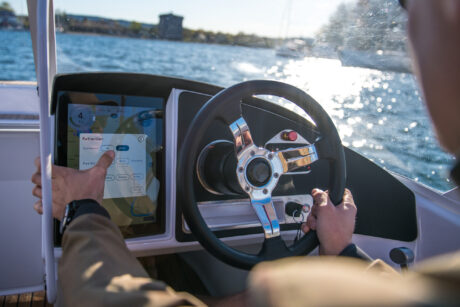Hydrofoil: this is the name of a technology that is recently living a revival but it is not new. To be more precise, in fact, in the past many researches, from both United States and Russia, concerned the hydrofoil – for civil and military uses. The news is that currently its application ambits are widening and notable technical improvements are under implementation.

Hydrofoil: little friction, highest speed
Let us proceed in order. What do we mean with hydrofoil? We define hydrofoil a lifting surface – also called foil – that operates in water. The hydrofoil look, in fact, is very similar to aircraft airfoils. The physical operation is similar as well and it is subjected to fluid-dynamics and hydrodynamics laws. When the speed of the means on which it is mounted increases, the hydrofoil generates a thrust that is equal to the means’ weight – generally a boat but it is used on surfs or kites, too – pushing the hull out of water, in this way notably decreasing friction and then enabling higher speed. The advantage? More efficiency and a decrease of the fuel use, even up to 35% for motors; concerning surfs or kites, the possibility of reaching high speeds even with low waves or moderate winds.
Main typologies
There are two main types of hydrofoils:
- Piercing: (generally V-shaped)
- Fully submerged (generally with the shape of an inverted T)
The first use V-shaped foils, part of which raise above water. They feature simpler construction, they are more affordable economically and they are less affected by swinging movements. However, they are not efficient in case of high waves, because they can fully emerge from water, decreasing their effect.
The second are more popular among water sports, they are less subjected to waves’ effects and therefore more stable at sea and more comfortable for crew and passengers. However, the fully submerged hydrofoil is not self-stabilising and needs an excellent stabilization system of the foil itself by means of flaps and, on board, a set of computerized sensors to keep the hydrofoil stable.
In general, hydrofoils consist of front wings, at present almost all of carbon, fuselage and column whose sizes and whose ratios depend on the target to be hit. Short wings (and then short fuselage) will permit agility in narrow spaces; larger wings, which provide less resistance, will allow going in speed and going up the wind.
Excellent energy efficiency potentials
The energy and cost saving potential offered by the hydrofoil is especially perceivable in ship and boat applications, where it immediately results in a fuel saving.
The Dutch company Hull Vane has developed a hydrofoil for a sailing yacht of the America’s Cup, which can reduce the fuel consumption by optimizing the water flow around the rear part of the boat. According to the Dutch company that has developed and optimized this technology for the energy and emission saving, the overall performances depend on the ship length, on the travel speed and on the hull shape in the stern sections. However, tests have confirmed it is possible to obtain a fuel saving ranging from 5 to 15% for many commercial and military ships and in some cases the benefits in fuel consumption might even reach 20%. Not only. Through an optimization of the hydrofoil design, we can achieve even better energy performances. As a matter of fact, according to the results of a computational fluid dynamics (CFD) study carried out by the Defense Materiel Organization (MDO) of Royal Netherlands Navy on an Offshore Patrol Vessel (OPV), they have determined that most of the fuel is used at speeds included between 15 and 20 knots. Optimizing the hull fin for these parameters would allow achieving further savings of fuel and then CO2 emissions.
Hydrofoil makes electric fly, too
Today the electric is trying to make its way also in the yachting sector but making fast electric boats is very difficult. To overcome the water friction, conventional hulls need enormous batteries to reach higher speeds. However, this increases their weight and cost, without anyway rising their speed proportionally, then standard electric boats have much lower autonomy than fossil-fuel competitors. For this reason, the Swedish electric Candela C-7 speedboat has been equipped with a hydrofoil and now it “imitates aircrafts to fly above the water”, reducing friction and finally permitting long electric autonomy at sea. This makes Candela C-7 the first electric boat in the world that combines long-range autonomy and high speed. The 6-passenger daycruiser flies above waves at a speed of 30 knots, using very little energy from its 40-kWh battery.

Hydrofoil is the secret of its efficiency indeed. The two-winged hydrofoil, combined with state-of-the-art computers, software and sensors, at speeds exceeding 14 knots, supplies a sufficient lift to lift the hull above the water, reducing the water friction by 80%. This allows an autonomy of 50 nautical miles at 22 knots, which is three-time higher than any other fast electric boat on the market.
If you combine the hydrofoil technology with state-of-the-art computerized control technologies, then the result is even more astonishing. In Candela C-7, for instance, the hydrofoil is adjusted by a computer resembling flight controllers used in modern fighter aircrafts. Hydrofoils are automatically regulated 100 times per second to assure stability. The result is an extremely smooth and completely silent ride, even in presence of wind and waves. Due to the efficiency of foils and to the aerodynamic electric propulsion unit, the operation cost of a C-7 is 95%-lower than a conventional fossil-fuel boat. At a cruise speed of 20 knots, the energy consumption per nautical mile is just 0.8 kWh, the equivalent of 0.2 litres of petrol. Hydrofoil is really a technology that can make the electric pleasure boating competitive.



